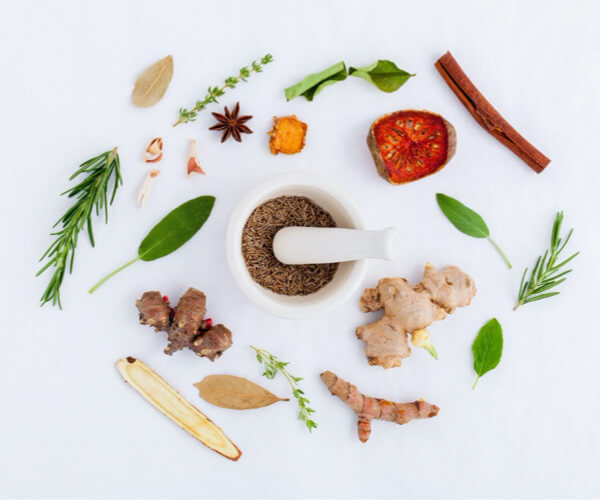By Science & Fourchette
Essential in the kitchen, spices, condiments, and sauces are great for taking recipes to the next level. Like an orchestra conductor, they bring an element of complexity to dishes and take us on a culinary journey across the world.
Experimenting with spices in the winter is ideal! Not only do we tend to have more free time to cook, but homemade dishes bring comfort and warmth during colder months.
Here’s everything you need to know before diving in!
Spices
Spices come from different parts of plants. It can be the bark, the flower, the fruit, the root, or the grain. For example, cinnamon sticks originate from the inner bark of the cinnamon tree. Ginger and turmeric are both roots that are typically grated or used in dried form. Because spices are extremely aromatic, spicy, or fragrant, you only need a very small amount to add depth to your favourite dishes.
Spices are generally sold whole, ground, or dried. Your best bet is always to opt for whole, organic spices, as they stay fresher longer and are more aromatic. When you’re ready to use them, simply grind them up with a mortar and pestle or in a small coffee grinder.
Whole and ground spices, as well as dried herbs, can keep for several months (between 3 and 24 months on average), if they are stored in air-tight containers and kept in a cool, dark, and dry space. Dried herbs and spices don’t ever expire. Therefore, they’re never bad to consume, but might lack a bit of flavour if you’ve had them for a while!
10 useful and versatile spices to always have on hand
Peppercorn, hot peppers (cayenne, paprika), cloves, cinnamon, vanilla, fennel seeds, ground ginger, cumin seeds, coriander, and salt.
Aromatic herbs
People often confuse aromatic herbs with spices. And it’s normal—fresh herbs serve almost the same purpose as spices. Because they have more subtle flavours than spices, they’re great in slow-cooked dishes. When buying your herbs, opt for some that are vibrant in colour. Once at home, transfer them to an air-tight container (125-ml Mason jars are perfect!), as they tend to lose their fragrance quickly otherwise.
5 useful and versatile aromatic herbs to always have on hand
Basil, oregano, thyme, parsley, and bay leaves
Encadré
The golden rule when it comes to replacing fresh herbs with dried herbs is to diminish the quantity by a third (1/3). For example, if you wish to replace 1 tbsp. (15 ml) of fresh oregano, simply use 1 tsp. (5 ml) of dried oregano.
Life-saving (and time-saving) mixes
Spice mixes (e.g. curry, chili, ras-el-hanout, 5-spice, allspice, etc.) are bought already ground and blended. It is therefore not necessary to do it yourself, which saves you time in the long run. It’s always good to have a few spice mixes on hand to add a bit of kick to your recipes.
Some of our favourite spice mixes available at Rachelle Béry include the fish and meat spices by Joe Beef, the Stockholm lemon and dill mix by Kanel, and the Silk Road blend Épices de cru.
Sauces and condiments
Condiments are a mix of spices, aromatics, or herbs with other ingredients, such as vegetables, broth, etc. Condiments are used just like spices—to season and elevate recipes. Think mustard, ketchup, sauces (spicy, BBQ, Worcestershire, etc.), and salted herbs.
Some of our favourites at Rachelle Béry include the harissa pepper paste by Mina, the organic smokey BBQ sauce by Bio bandits, and the Peri-Peri sauce by Nando’s.
Too much or too little?
When people start cooking with spices, condiments, and sauces, they often ask the same questions: Should they be added at the start or end of a recipe? Is there a risk of adding too much and ruining the dish?
It all depends!
It’s best to add whole spices at the beginning of the cooking process. That way, dishes that simmer for a while will slowly develop their flavours. When it comes to ground spices, it’s best to add them to quick-cooking dishes or right before serving.
When cooking with spices, it’s important to have fun and try new things! Start by adding a little, taste, then add more if you want. It’s better to add flavour gradually then to overpower your dish in one go.



